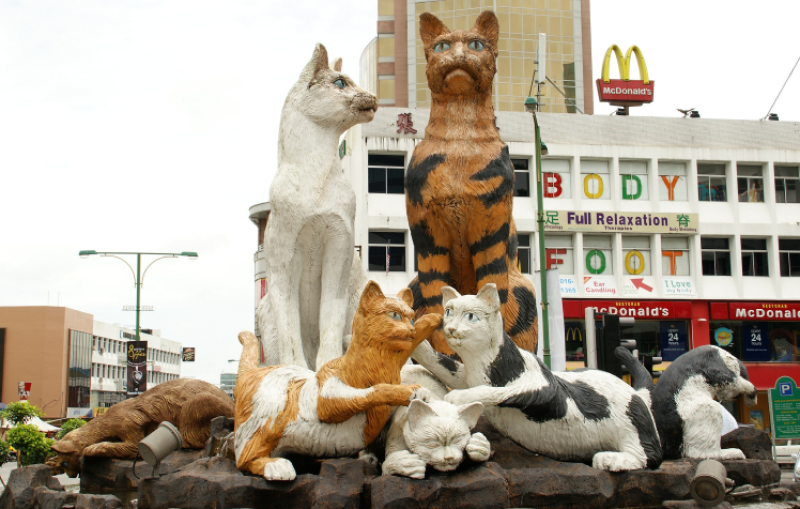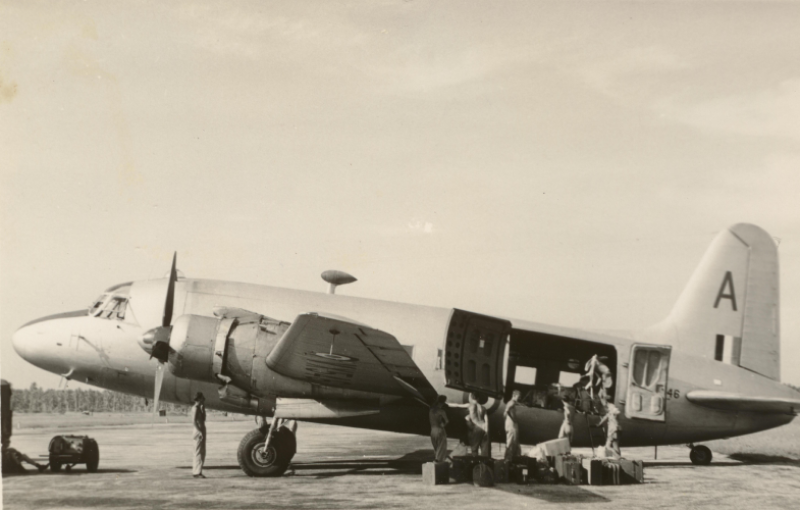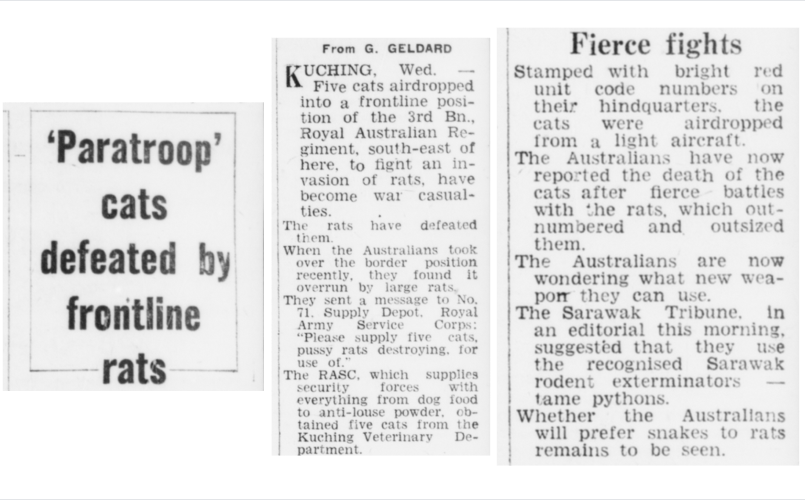It’s a Cat’s Life: Airborne Felines Fight in War Against Rats
In 1960, 23 unsuspecting cats found themselves being airdropped into Bario, Sarawak, as part of a rat-busting operation.
By Ho Sie Sie
In tropical Sarawak, it often rains cats and dogs. On 17 March 1960, somewhat unusually, it rained only cats – 23 cats to be precise. The cats, together with 7,000 lb (3,175 kg) of equipment and supplies, were parachuted by the Royal Air Force (RAF) into Bario in the Kelabit Highlands in Sarawak, from a height of 400 ft (122 m). “It ‘rained’ cats in the Bario District of the Kelabit Highlands in Sarawak,” announced the Singapore Free Press.1
After five test runs over the drop zone, the cats were dropped off via a “giant Beverly transport” plane. The Straits Times reported that “[h]undreds of excited Kelabits on the ground watched the big operation which took more than an hour”.2
“[The cats] landed bang in the middle of the zone. After the operation, the operations officer of the Sarawak Civil Aviation Department, Mr John Seal, congratulated the R.A.F. on ‘a magnificent job’.”3 Operation Cat Drop was a success.

Operation Cat Drop
Bario is a remote hamlet in the Kelabit highlands deep in the interior of Sarawak. In 1960, Bario’s rice crops were plagued by an infestation of rats. Their call for help was answered by Kuching, Sarawak’s capital. Kuching (which means ‘cat’ in Malay and is also known as the City of Cats) appealed for at least 30 cats (ultimately they were only able to find 23) for the mission. The cats were to be “packed expertly into wicker baskets and parachuted into the padi”4 to combat the aggressive rats. Located 4,500 ft above sea level and inaccessible by road,5 the RAF felt that the easiest way to send the cats to Bario was by air.

A month after the “army of cats from heaven” were released, the Kelabit sent Kuching this message on 18 April 1960: “Thanks for the cats – no more trouble with rats and mice.”6
Flying (and Falling) Felines
The Kuching cats were not the first felines to be ferried by the RAF on pest infestation duties. In December 1953, the RAF delivered a cat to the men at Fort Legap in Perak. The cat was “sent down in a specially padded box along with the rations” to deal with rats that had been eating their rations. It is not clear if this cat was parachuted to Fort Legap. The terse news report merely said that the RAF plane had “dropped a live cat to men.”7
However, a few months after that, the Straits Times reported without ambiguity that two cats (one black, one white) were dropped from a height of 350 ft (106 m) in parachute containers from an RAF Valetta to an airfield in Kuala Lumpur.

A jungle fort in north Malaya had requested for cats to chase away rats and mice that had been destroying their food supplies. To deliver the animals to the remote location, the RAF wanted to see if was possible to parachute the animals down.8
The cats seemed to take the experience well. “[The cats] both seemed quite jolly about the whole thing. They were none the worse for the parachute drop… When the seals were broken, the two cats jumped out of their airborne container, licked their paws, and walked away,” the Straits Times on 21 June 1954 reported an officer of 55 Company RASC (Royal Army Service Corps) Air Despatch as saying. Deeming the experiment a success, the plan was for the cats to be parachuted later that week to do their job in their new home.9
Other Cat Missions
While the cats were undoubtedly excellent hunters, the platoons of airborne cats were not always successful in their missions. One tragic event took place in Sarawak in the mid-1960s. During Konfrontasi (the Indonesia-Malaysia confrontation) in mid-1960s, Australian military units were stationed in Sarawak to protect Malaysia from potential attacks by Indonesian forces.10 When the Australian troops took over the position in 1965, they found it was “overrun by large rats”. They asked the RASC for five cats to resolve the problem. The cats were obtained from the Kuching Veterinary Department by the RASC.11
However, on 22 April 1965, the Straits Times reported the sad news that “[the] five cats air-dropped into a frontline position of the 3rd Bn. (Battalion), Royal Australian Regiment, south-east of [Kuching], to fight an invasion of rats, have become war casualties”. The Australians reported that the cats had been killed by the large and aggressive rats. The Sarawak Tribune suggested to use tame pythons, which were “recognised Sarawak rodent exterminators”. 12

In response to the news of the cats’ demise, the RAF in Labuan had some advice for “any military unit throwing cats into action against border rats: Get them in peak condition first by feeding them well”.13
A grey-and-brown tabby named Mum was held up as proof that well-fed and cared-for cats would make quick work of rats. “[R]ats in the Bario area of Sarawak’s Fourth Division seem to have met their match in ‘Mum’… [In the officers’ mess on Labuan], she lived on the fat of the land – chicken, beef, mutton and fish.” However, in response to an SOS request for a cat from 101 Squadron in Bario, Mum and her three kittens were sent off to duty by helicopter. The foursome were reported to be “more than holding [their] own against overwhelming odds”.14
Their martial ability aside, there were also instances where some cats proved to be less than willing to engage in their duties. On 14 June 1966, the Straits Times reported the disappearance of two “tomcats recruited to reduce the bush-rat population in company areas of the 4th Bn. Royal Australian Regiment”. “Two ‘trackers’ in an Australian infantry unit in Borneo are AWOL after being on duty for less than an hour. All hope of finding them has been abandoned and searches called off. Army authorities say that if they turn up they face a cat-martial with a maximum sentence of 14 days CB (confined to baskets) and a ratless diet of rice and fishheads.”15
It is unclear when the RAF stopped airdropping cats to remote locations. Advancements in pest control and alternative methods in controlling the rat population, coupled with improved road infrastructure and construction, likely spelled the end of the practice.
 Ho Sie Sie is a manager at Resource Discovery and Management, National Library Board. When she’s not looking at books, she’s looking at cats.
Ho Sie Sie is a manager at Resource Discovery and Management, National Library Board. When she’s not looking at books, she’s looking at cats.Notes
-
“It Rained Cats in Sarawak,” Singapore Free Press, 17 March 1960, 7. (From NewspaperSG) ↩
-
“Those Cats Go in Bang on Target,” Straits Times, 22 March 1960, 2. (From NewspaperSG) ↩
-
“Wanted: 30 Flying Cats to Rout Rats,” Straits Times, 9 March 1960, 5. (From NewspaperSG) ↩
-
“Rural Boy from Sarawak,” Business Times, 19 April 2008, 3. (From NewspaperSG) ↩
-
“Paracats End Rat Menace to the Crops,” Straits Times, 18 April 1960, 7. (From NewspaperSG) ↩
-
“Cat Came by Plane,” Straits Times, 20 December 1953, 1. (From NewspaperSG) ↩
-
“Two Jolly Sky Cats Jump from Bomber,” Straits Times, 21 June 1954, 1. (From NewspaperSG) ↩
-
“Indonesian Confrontation,” National Museum Australia, accessed 1 April 2024, https://www.nma.gov.au/defining-moments/resources/indonesian-confrontation. ↩
-
“Paratroop Cats Defeated by Frontline Rats,” Straits Times, 22 April 1965, 18. (From NewspaperSG) ↩
-
“Survival Tip for Front-line Pussy,” Straits Times, 1 June 1965, 15. (From NewspaperSG) ↩
-
“Two Face Catmartial If Caught,” Straits Times, 14 June 1966, 9. (From NewspaperSG) ↩

